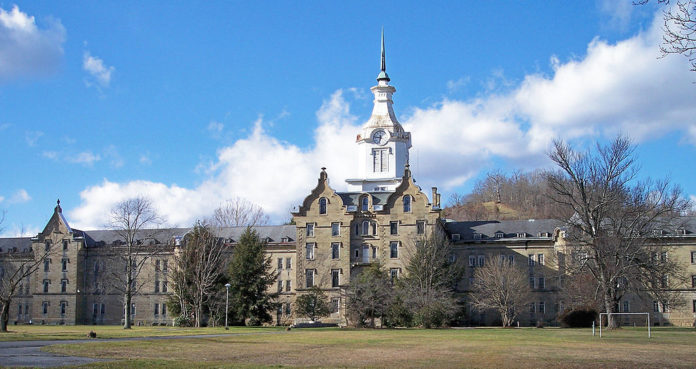
The fall air was breezy and as I became fully exposed to the chilly West Virginia wind, I felt an overwhelming sense of autumn nostalgia. October was more than halfway through, and I was quickly running out of daylight. I had reached my destination; the Trans-Allegheny Lunatic Asylum, formerly known as the Weston State Hospital. Now simply a hollowed-out shell turned tourist attraction, at one time this extraordinary landmark served as a fortress that housed the mentally ill. All that remains now are the tragic tales of depression and desperation, violence and lunacy that were hidden behind the hand-cut stone exterior.
In the early 1850s, the hospital was authorized by the Virginia General Assembly under its original name, the Trans-Allegheny Lunatic Asylum. It was designed in the Gothic Revival and Tudor Revival styles and in late 1858, construction began. Initially, prison laborers were used to begin the creation but soon, skilled stonemasons took over. In 1861, the construction of the hospital was interrupted by the onset of the American Civil War. Once West Virginia became a state, ownership of the property was retained and the name of the hospital was changed to “The West Virginia Hospital for the Insane.” Although patients were first admitted in 1864, the structure wasn’t completed until 1881.
Over the course of the following century, the hospital experienced many changes in terms of patients, staff, amenities, and policies. The facility ultimately became over-crowded and some treatments were deemed cruel. In 1986 under the Arch Moore administration, plans were announced to convert the Weston Hospital into a prison and build a new psychiatric unit somewhere else in the state. Those plans never developed fully. Instead, the William R. Sharpe Jr. The hospital was erected in Weston and in 1994, Weston State Hospital was closed. In 2007, the property was purchased by Joe Jordan, a demolition contractor for the sum of 1.5 million dollars. These days, the building is kept open as a site of heritage and tours of the grounds are offered. The focus of this National Historic Landmark’s (1990) continuity seems to be on the supernatural aspect. Personal accounts of ghostly encounters have poured out of the mouths of many who have visited the asylum in the past decades.
I traveled north on I-79 to Weston to experience firsthand the splendor and mystery of one of West Virginia’s most prized and nationally known landmarks. Not only do I enjoy stunning architecture, but I am truly fascinated by supernatural locations. The Trans-Allegheny Lunatic Hospital is often at the top of every list about paranormal hotspots in West Virginia. It has a well-deserved reputation for being a creepy place with a haunted history. As I entered Weston, I proceeded to 71 Asylum Drive and it took only a glance at the building to realize I was in for an incredible experience.
My first reaction to the old hospital was sheer awe. From a distance, the immense structure casts a gothic shadow over its grounds. As I approached, it felt as if the looming edifice was gazing down on me. An ominous sky further set the mood and provided the perfect backdrop. An aged fountain rested peacefully at the end of the long driveway that connected the hospital to the outside world.
As I approached the entrance, I couldn’t help but notice the sensational views of the asylum grounds. Originally, the hospital was built to be completely self-sufficient. On the 666 acres of property were a dairy, gardens, waterworks, and even a cemetery for the bodies of unclaimed patients. I pondered what other secrets this distinctive place might hold. Standing on the outer steps, I gazed up at the white clock tower which vaguely resembles the steeple of an old country church. Admiring the stone structure in all its splendor, I took a deep breath and prepared to embark on a journey that would reach into the depths of my consciousness, then I walked inside.
The overwhelming sense of history and the acute smell of mustiness flooded me as I entered the lobby area, where tour tickets are now sold. While I waited for the next tour to begin, I wandered off into a small room on the right side of the lobby. A couple of hospital relics captured my eye immediately. An old wooden wheelchair and antique metal gurney brought forth images of former patients being rushed back and forth through the wings and corridors of the asylum. It was then that I questioned, “Have the patents ever really left at all?”
Soon it was time for our tour and a guide shuttled our small group through a set of rickety doors. We quietly walked behind the guide who enlightened us about some of the history and mystery of the asylum. As we entered the Civil War section we heard some interesting details about the construction of the building. The property sparked early controversy due to the state ownership disputes when Virginia seceded from the Union. When West Virginia became a state, the quarrel was settled. West Virginia retained ownership of the property and the construction was completed. Focusing on the cracked windows with weathered panes, and bracing against the time-beaten walls, it wasn’t difficult to picture the days and nights when soldiers moved through the area, taking up lodging in the hospital.
As we continued on through the empty halls, it became clear that while much of the building looked the same, each room had a different unsettling story. Tales of insanity, torture, and other wicked behavior plagued every square inch. For example, in one of the rooms, upon the cold concrete floor, a vicious murder had taken place directly where we stood. As the tour guide relayed the vividly detailed story, my mind became filled with the sights and sounds of such a brutal attack. Inhumane procedures were commonplace such as lobotomies and electric-shock therapy. It was unnerving to hear such horrendous stories.
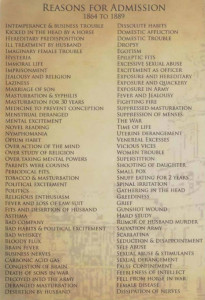
For me, one of the worst aspects of institutionalization is extreme isolation. Nothing evokes loneliness and solitude the same way as being locked inside of a compact square room, isolated from one’s world, self, and spirit. On the inside, I felt only a small fragment of what it must have been like to be a patient. Being kept from friends and family was a common practice during a patient’s stay at the hospital. They were isolated for different reasons; some were considered dangerous, others were thought to be carrying contagious illnesses and many were simply defiant. It was the quintessential paradox: those who suffered no mental illness could not get anyone to believe them because one of the leading symptoms of insanity was denial. Taking into consideration some of the “causes” for committal provides a disturbing feeling: feebleness of intellect, parents were cousins, political excitement, laziness, egotism, and women, among other things. Most patients rejected the theory they were ill, but according to the experts, that only confirmed those conclusions.
The tour proceeded outside for the opportunity to experience some of the property’s stunning landscape. There were just as many sobering sights on the outside as on the inside. Many of the other buildings on the grounds possessed haunted histories and stories that were somberly recalled by our knowledgeable tour guide. We learned of a patient who was reported missing and whose body was finally found hanging in the greenhouse. We strolled by the brick-layered psychiatric unit which formerly housed patients suffering from Tuberculosis. Also, this was the section of the asylum where most of the “up-to-date” treatment methods were practiced, including electroshock therapy and lobotomies. Sadness flooded through me as I imagined just how dire the situation was for many of the patients at the Weston State Hospital.
On the inside, the asylum was broken down and decrepit, revealing peeled wall paint, cracked window glass, destructed floor tiles, water stains, as well as slithering weeds overtaking the walls and corners of the rooms. In contrast, the outside was nothing short of immaculate. The structure, one of the largest hand-cut stone masonry buildings in the country (242,000 sq. ft.), boasts beautiful gothic architecture. Several gargoyles overlook the grounds as we followed the trail around to the anterior side of the hospital. It was as if they watched us carefully, protecting the sacred hallowed grounds on which we were treading, commanding our respect. One more look up at the setting sun behind a dark sky told me that, like many of the former patients at Weston, the day was slowly dying. This thought led me back through the large exterior doors at the rear of the hospital, back to the inside.
The final part of the tour was the infamous “third floor.” Having previously heard accounts and rumors about the old place from others, I was already aware of the site’s “haunted reputation.” As I wound my way up the spiral staircase, I recollected some of these paranormal experiences. Whispering voices, childish laughter, and phantom footsteps are often documented and witnesses are more than willing to go on record with the details.
In 2008, the television series, “Ghost Hunters,” shot an entire episode in the empty asylum. At the time of my afternoon spent there, I had not seen this particular episode. Therefore, all of my experiences were free of biased commentary from ghost hunters, paranormal enthusiasts, and highly creative attention seekers. In October of 2009, the producers went back for a second time and filmed six hours of live-action during the late hours of the night. One thing I knew for certain: ghosts or no ghosts, the old Weston State Hospital was the creepiest place on which I had ever set foot. Something told me that my experience was only going to get stranger with each walking step. As I topped the last stair leading onto the landing, I wondered if I might leave that night with a paranormal story of my own.
The floors were solid stone and the echo of each footstep made it sound as though I wasn’t treading there alone. The halls were dark and silent. Sometimes knowledge of tragic “real life” events is far more frightening than anything supernatural. I ambled on, a little uneasy, wondering if every stain I encountered was simply age and rust, or much worse; evidence of something terrible that happened so many years ago.
Most of the tour group pulled an early exit following the outside portion. By this time, only a couple of individuals remained. At that point, we were allowed to split up. I was by myself, free to roam the quiet halls as I pleased. Certainly, this made my experience on the third floor all the more personal, and all the edgier. I walked into a deserted room and remember thinking that although the room appeared vacant it somehow didn’t feel empty at all. It was as though the room was alive with whispers of long-gone voices and energetic sensations from past events. I peered out the only window in the room, gazing at the sleepy town of Weston. Looking out at the real world, I felt as though I might as well have looked down from an airplane high above the Earth. It seemed impossible to think I could easily walk down the stairs and out the door. Instead, I felt alone, trapped on the inside, isolated. Eventually, I turned and walked out, only to discover later that a brutal murder had taken place in that very room, many years before.
When thinking of an asylum, I always envisioned everything to be white and bright, with many lights and padded walls. The cliché objects like padded walls and straight jackets had been long since removed from the Weston State Hospital. However, instead of being solid white, the upstairs walls had been painted a very odd combination of two-toned white and pink. I found this striking as I headed down one of the long corridors, back towards the stairs. Next, faint sounds began echoing behind me. It was the resonance of pattering feet and whispering voices. I couldn’t distinguish any real words, but the sounds were clear. I turned around only to find emptiness. Quickly, I snapped a photograph on my digital camera. A cropped image of that particular photograph later revealed that I had captured the image of what appeared to be a young girl dressed in black, cast upon the wall. Was it simply a shadow? Or was it something more, something not of this world? I’ll never be sure, but I have an opinion. Although I wasn’t aware I had possibly captured an asylum ghost on camera, the three hours I spent at the hospital provided me with enough experiences and memories to last for quite some time. At that point, I decided it was time to leave the Trans-Allegheny Lunatic Asylum.
Going back downstairs, I tipped my tour guide at the bottom, and then walked outside, back into the world. The memories and experiences I took away from the asylum are unforgettable. The pain of its history shines in the darkness there. It is evident by scars on the walls, names in the record book, and in the hallowed grounds themselves. The day had grown late, and as I drove away from the Trans-Allegheny Lunatic Asylum, I was reminded insanity doesn’t always exist in the human mind, but sometimes within the stone walls, concrete floors, and broken windows of an extraordinary building.
True West Virginia Ghost Stories eBook
Our complete story collection is now available as an 880 page digital ebook that you can download to your computer or mobile device. After downloading your copy of the ebook, you can read it anywhere without needing an internet connection.
... or feel free to make a contribution.

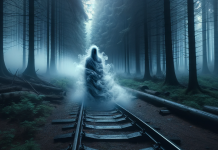
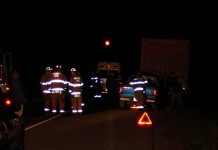
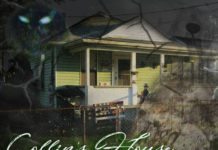
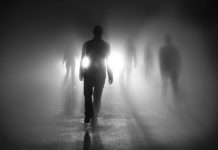

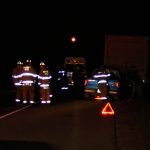
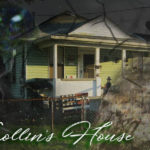
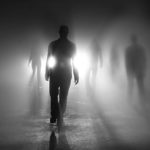

Have you ever seen the list of reasons for why they would admitt people in there? You can google and find the list i do believe. It is beyond crazy some of the reasons. Im from weston, born and raised. We studied the hospital all threw school. Some of the things ive experienced and remember from that hospital have made me a firm believer in the supernatural.
I agree…the list of reasons for admitting people is outlandish. I have a book on the institution’s history, and there’s a section which lists different “diagnoses” that were admitted. Of course, some of the things listed in the DSM-V and previous editions as to what constitutes a psychiatric disorder can be pretty outlandish…
I really want to go!!!!!!!!!!! I have done a ton of research, and find it really interesting. I hope I can go soon!!!!!!
I was just there last night with some family, we unfortunately were too late for any tours, but we walked around the area until an employee asked us to leave. But we saw shadows in the windows up on the 3rd floor and in a room on the 1st floor (Lilly’s room) there was a ball bouncing in the middle of the floor. I can’t wait to go back for an overnight tour!